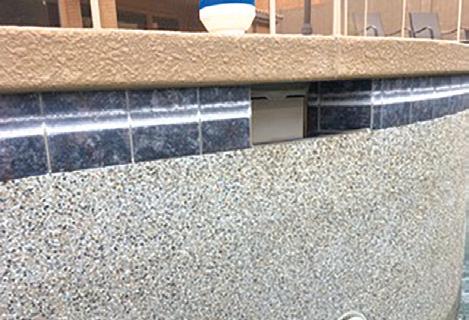www.ahwatukee.com




www.ahwatukee.com



Developers of a proposed 417-unit apartment complex on 50th Street between Ray Road and Chandler Boulevard will go before the Ahwatukee Foothills Village Planning Committee next Monday for a vote in a formal city review process they hope to complete in about six weeks.
Hoping to go before the city Planning Commission Jan. 5 and Phoenix City Coun-



cil Feb. 1, P8 Phoenix Foothills Holdings LLC is asking for height and density waivers to allow for multifamily residential development on a site about 1,500 feet south of 50th Street and Ray Road that is now occupied by the two-building Commerce Park. The 6 p.m. Dec. 19 VPC hearing is online only and people who want to speak can get a link to the meeting at phoenix.gov/cityclerksite/PublicMeetings/221219001.pdf.
They can also get the agendas for the future Planning Commission and council meetings at phoenix.gov/cityclerksite/PublicMeetings.
The apartment project is not far from a mammoth light industrial office park called the Converge Logistics Center already under construction around 50th and E. Thistle Landing.
There, Via West is seeking a zoning change to allow for a wider range of tenants and that could generate as many as 1,800 new vehicle trips a day, mostly onto Ray Road. That request had been expected to go before the VPC this month but is
They had made their decision to run for the Arizona House of Representatives within a few weeks of each other in October 2021.
For Patty Contreras, newly retired after working mainly as a program manager for the city Human Services and Parks and Recreations departments for 31½ years, the decision seemed a logical step in a lifetime of public service.

Increasingly unhappy about the legacy she saw being left to her two daughters –and children generally – scientist and military veteran Stacey Travers decided it was time for her to try and change that narrative.


And on Jan. 9 – a month after they captured a lead in the General Election that was never seriously in jeopardy – the two

Next month, Ahwatukee residents Patty Contreras, left, and Stacey Travers will be sworn in as Arizona House of Representatives members representing Legislative District 12, which includes Ahwatukee, northern and west Chandler and part of Tempe. (Special to AFN)


The Ahwatukee Foothills News is published every Wednesday and distributed free of charge to homes and in single-copy locations throughout Ahwatukee Foothills.
Times Media Group:
1900 W. Broadway Road, Tempe, Arizona, 85282
Main number: 480-898-6500
Advertising: 480-898-5624 Circulation service: 480-898-5641



National Advertising Director
Zac Reynolds 480-898-5603 zac@ahwatukee.com

Advertising Sales Representatives: Laura Meehan, 480-898-7904, | lmeehan@ahwatukee.com Katie Mueller, 480-898-7909 kmueller@TimesLocalMedia.com

Classifieds/Inside Sales: TJ Higgins, 480-898-5902 tjhiggins@TimesLocalMedia.com


Steve Insalaco, 480-898-5635 sinsalaco@TimesLocalMedia.com
Executive Editor:
Paul Maryniak, 480-898-5631 pmaryniak@ahwatukee..com
GetOut Editor: Christina Fuoco-Karasinski, 480-641-4518 christina@TimesLocalMedia.com
Sports Editor: Zach Alvira 480-898-5630 | zalvira@TimesLocalMedia.com
Designer: Ruth Carlton | rcarlton@TimesLocalMedia.com
Photographer: David Minton | dminton@TimesLocalMedia.com
Production Coordinator: Courtney Oldham 480-898-5617 production@@TimesLocalMedia.com
Reporters: Cecilia Chan. 480-898-5613 | cchan@@TimesLocalMedia.com
Circulation Director: Aaron Kolodny 480-898-5641 | aaron@phoenix.org
Distribution Manager Brian Juhl brian@TimesLocalMedia.com
Ahwatukee Foothills News is distributed by AZ Integrated Media, a circulation service company owned by Times Media Group. The public is limited to one copy per reader. For circulation services please contact Aaron Kolodny at aaron@phoenix.org..
Stating Phoenix confronts $1.2 billion in unfunded needs, the city administration is hoping voters will let it borrow $500 million that it concedes will cover far less than half of that amount.

In a lengthy memo to council that was scheduled to be discussed in a hearing Dec. 13, City Manager Jeff Barton recommends that just over a quarter of the $500 million go to public safety and about 16% for streets and storm drainage.
The proposal also calls for 10% of the borrowed funds, or about $50.4 million, to go to arts and culture programs – with $21.6 million of that earmarked for a new Latino Cultural Center and $14 million for the Valley Youth Theater.
Barton said that after a study of the city’s capital needs, staff divided the total into $647 million of “prioritized capital needs representing the most urgent needs identified by staff while offering balance among the city’s service categories.”
The remaining $505 million in projects were “determined to be less urgent” or “better suited for deferral to a future bond program.”
To start or stop delivery of the paper, please visit: https://timespublications.com/phoenix/ or call 480-898-7901
To get your free online editiona subscription, please visit: https://www.ahwatukee.com/e-subscribe/
To submit a letter, please include your full name.
Our policy is not to run anonymous letters. Please keep the length to 300 words. Letters will be run on a space-available basis. Please send your contributions to pmaryniak@ahwatukee.com.
EDITORIAL CONTENT
The Ahwatukee Foothills News expresses its opinion. Opinions expressed in guest commentaries, perspectives, cartoons or letters to the editor are those of the author.
The content and claims of any advertisement are the sole responsibility of the advertiser. The Ahwatukee Foothills News assumes no responsibility for the claims or content of any advertisement.
© 2022 Strickbine Publishing, Inc.
Conspicuous by its absence is any funding for an additional public safety facility to improve fire and emergency response times to communities in western Ahwatukee and any specific improvements to Ahwatukee parks.
The administration is recommending nine specific park projects in other parts of the city whose cost totals $62.5 million of the $64 million proposed for parks with the remainder earmarked for “minor capital projects” citywide.
Overall, Barton is proposing to divvy up the $500 million this way:
$132.5 million for public safety, with four new fire stations, the replacement of one police precinct and renovations to the property management warehouse
not on Monday’s agenda.
With some neighbors concerned about the impact of both projects on already nightmarish traffic on the busy strip of Ray Road between 48th Street and the I-10, the Phoenix Street Department has given the area what it hopes is an early Christmas present.
Street Department spokeswoman Heather Murphy told the Ahwatukee Foothills News last week that after hearing of neighbors’ concerns about the timing of traffic signals on that stretch of Ray, the lights have been re-synchronized.
“I don’t know if people will sense the difference right now because it’s the holiday shopping season,” Murphy said, referring to the string of businesses on both sides of Ray.
“Once we finally got all the details about what people were concerned about, they were able to make some changes,” she said about city engineers.
Murphy did not know if the Arizona Department of Transportation has addressed the other cause of the Ray Road bottleneck – the signals on the I-10 overpass, which the same neighbors have complained affect eastbound traffic flow all the way from 48th.
ADOT could not be reached for comment.
But Murphy said, “Our team is really good about coordinating with ADOT, so if they needed to make any changes, I’m sure our team was in contact with them.”
During an online neighborhood meeting Nov. 1, developers Everest Holdings and PB Bell detailed their plans for the apartment complex.
They would raze the two-building office complex at 15210 S. 50th St., according to a letter that the law firm of Gammage & Burnham sent neighbors earlier this month.
“The proposed development will revitalize the property, which currently contains two underutilized office buildings, with a 417-unit high-quality multifamily residential community that will provide additional housing opportunities to support existing and planned commercial and employment uses with the Ahwatukee Foothills Village Core and along Interstate 10,” they wrote.
The developers would build four three-story buildings and two four-story buildings housing what they call “high-
ly amenitized” apartments aimed at “high-earning” single professionals and couples, according to the neighborhood meeting presentation held last month by attorney Manjula M. Vaz and PB Bell Principal R. Chapin Bell.
Bell said the complex would be no different from the complexes he has developed in the Valley over 42 years that house more than 20,000 apartments.
“We focus all our developments on really high quality, highly amenitized communities in markets that really have a need for housing,” he said.
Plans submitted by Everest Holdings indicate the two four-story buildings, which will be about 48 feet high, will be around the pool and clubhouse.

In all, there would be four clusters of buildings “with ample resident parking

and guest parking,” Bell said, “with lots of beautiful access drive aisles” that would “minimize any walking that needs to be done.”
Bell said outdoor amenities will include a dog park, a multipurpose lot with barbecue areas, a fire pit and a tot lot.
The buildings “are designed to envision a timeless modern architectural style for the community,” he added, “through a mixture of extra materials that includes faux wood siding, stone veneer, brick veneer and each of these materials complements the modern design which you’ve seem put there a lot lately.”
“We cater to both old and young business professionals that that have high incomes and who can afford to live in these communities but really want to live near the areas where they work,” Bell said, adding that only 8% of the units would have three bedrooms.
Bell and Vaz also said the complex would “strengthen the retail in the area” and would attract tenants who work in nearby office complexes.
Although residents who tuned in for the briefing were most concerned about the project’s impact on traffic, Vaz said their studies indicate the apartment complex would generate about 220223 additional vehicle trips during the
In analyzing ideas submitted by community groups and individuals, the city said the most suggestions came from District 6, which includes Ahwatukee, though it did not indicate areas within the district where those ideas came from. The total estimated cost of the District 6 suggestions was nearly three times the amount the city feels it can prudently borrow. (City of Phoenix)


BOND from page 3
and Maryville police precinct.
$81.5 million for streets and storm drain replacement citywide, with about $27.4 million of that reserved for flood and drainage mitigation in Laveen and an area around Dobbins and Baseline roads called the Hohokam Drainage Program.
ergy and water efficiency upgrades at city facilities, $7.7 million for “heat resiliency,” $3 million for brownfields redevelopment of city land and $1.3 million for electric vehicle charging stations.

$63 million for housing, human services and homelessness with $33.2 million earmarked for “affordable housing property preservation” and another $21.3 million set aside for housing development in the Edison-Eastlake community.
Barton’s recommendations culminate the first phase of an effort that began in August when a special citizens committee took testimony from citizens and community leaders in 34 hearings about the needs they wanted to be included in the general obligation bond.
$44.6 million for neighborhoods and city services, with more than two thirds of that going to three new libraries, $10 million for making city facilities more handicap-accessible and $5 million for historical preservation programs.
But before that wish list gets finalized for voter consideration in an election next November, council members will now begin jockeying for their own pet projects to be included in the list – more than likely at the expense of others already on there.


Besides the Latino Cultural Center and Valley Youth Theater, the remaining allotment for arts and culture includes $385,339 in “cultural facilities critical equipment replacements” citywide and improvements or expansion at the Children’s Museum, Phoenix Center for the Arts Theater, Phoenix Theatre Company and Arizona Jewish Historical Society.
$38 million for economic development and education, all going to three projects – $23.5 million, for the land acquisition along Rio Salado, $12 million for the ASU Health Technology Center and $2.5 million for the Spark Area.
$26 million for environment and sustainability, including $14 million in en-
While no formalized timetable for council action is listed in Barton’s memo, he previously indicated that he hoped it would be taken by next month so that the city could begin crafting a monthslong campaign to win voters’ acceptance of the spending plan.
He said the $500 million bond program “can likely be supported without any increase to the current secondary property tax rate of $0.8141 per $100 of net assessed valuation.”
“Peak debt service is not anticipated to rise substantially beyond the status quo maximum annual debt service of $155 million, and a bond program of this magnitude is not expected to adversely impact the City’s bond ratings,” he said, adding Phoenix’s overall debt “would
from page 5
additionally remain below Constitutional debt limits.”
He also said the amount being sought by the city “is not expected to adversely impact the city’s bond ratings.”

Even though the citizens executive committee signed off on the projects being present to council, committee chair Sharon Harper told council in a letter that the panel also hoped that two other projects would get special consideration “if additional funding becomes available.”

They are $5.7 million for Symphony Hall improvements and $6.9 million to expand the Parsons Center for Health and Wellness.
Harper also underscored the difficulty the committee faced in winnowing that array of projects down to an amount city staff projected Phoenix taxpayers can afford.
“The total population of projects recommended by the GO Bond Subcommittees totaled $717 million, requiring difficult decisions to be made to arrive at our recommendations,” Harper wrote.
“The City Manager recommended targets by subcommittee program area for our consideration to serve as a starting point for deliberations,” she continued.
“Determinants in development of each target included the ability of City staff to execute projects over the next five years, impacts to ongoing operating costs, and equitable distribution of projects throughout the City. The committee considered these factors and feedback
from page 4
morning and evening rush hours.
Vaz’s explanation didn’t satisfy resident Constance Holcomb, who has lived in the general area for 28 years.
Stressing she was not opposed to the apartment complex, Holdcomb said, “We are opposed strenuously to the amount of traffic that this is going to bring in, for the very reasons you’ve listed are the reasons that traffic will increase.
“It’s a nightmare for us out here,” she
from residents in our decision making.”
Bond programs cannot be used to cover operating costs, such as salaries or facilities not owned by the city.
But improvements to or expansions of city facilities covered by those bonds can increase operating costs down the road and the recommended projects submitted to council will result in an additional $26.8 million in operating and staff costs, according to Barton.
Those increased costs would be triggered mainly by the new fire stations and libraries, he said, and will be added to future General Fund budgets that already face the uncertainties created by inflation.
Barton also wrote that “it is not unusual” to ask for $500 million when Phoenix faces an estimated $647 million in “urgent needs.”
He noted that the voter-approved bond issue in 2006 – the last time Phoenix went into the market for general obligation bonds – the city had identified $3.2 billion in needs but only wanted to borrow $878 million.


Similarly, the city in 2001 won approval for a $754 million bond issue it sought despite its estimate of $2.8 billion in identified needs.
But Barton said the city can seek subsequent bond issues every five years that total $500 million each.
“Financial models indicate routine bond programs of this magnitude will continue to be sustainable without any material increases to property tax rates, assuming no significant legislative or economic changes,” he wrote.
said, adding, “The traffic signals are so messed up.”
Holcomb reiterated a concern she expressed a week earlier during a neighborhood meeting on the Via West project, which is estimated to generate 1,800 vehicle trips a day, mostly from trucks that the developer said would likely head north to Ray Road in order to reach I-10.
Bell said they anticipate starting construction in the third or fourth quarter of next year and estimated an 18-month timetable to complete the project.
















At Ahwatukee Dental Health, Dr. Amy Nordquist and her team are dedicated to providing each and every patient with the care and attention they need in the most comfortable way possible. Her time spent with you will always be thorough and focused on your dental concerns. Our team values personalized attention and long-term relationships with all of our patients. We can’t wait to meet you!
























 BY HOWARD FISCHER Capitol Media Services
BY HOWARD FISCHER Capitol Media Services
Lame duck Gov. Doug Ducey said last week that he won’t call a special legislative session to deal with problems with school funding before his term ends this month until he gets a promise that lawmakers will deal with some issues on his own agenda – including more money for the private school voucher program.
And that could scuttle any chance of giving schools an immediate assurance they won’t have to cut more than a billion dollars from their spending plans by July 1.
Hanging in the balance is tens of millions of dollars that East Valley school districts won’t be able to spend in the last quarter of the current school year even though they have the money – including an estimated $17 million for Tempe Union High School District and $17.6 million for Kyrene schools.

The governor acknowledged on Dec. 5 that he had agreed to bring lawmakers

back to the Capitol to waive the Aggregate Expenditure Limit’ if he could be shown that the votes were there. Such a move requires 20 of the 30 senators and 40 of the 60 representatives.
Lawmakers from both parties who support the waiver said last week they have the votes.



But Ducey, whose term is up at the end of the month, said that’s not enough.




“There are things in addition to the AEL that I’d like to see get done,’’ he said. The governor would not elaborate.
But Daniel Ruiz, his chief of staff, said providing even more state funds in vouchers for students to pay for private and parochial schools is “certainly a priority that’s been discussed.’’ So, too, he said, are issues ranging from border security to changes in election laws.
And that could scuttle any chance of quick resolution of the issue.
That would leave other East Valley districts in the lurch come spring, including Gilbert Public Schools with $39.9 million, Chandler Unified with $54.4 million and Mesa Public Schools with $73.8 million



in funds they have but can’t touch.
The problem is a constitutional cap, approved by voters in 1980, of how much can be spent each year on K-12 education. Adjusted for inflation and student growth, that limit now is $6.4 billion.
Lawmakers approved a major infusion of new funds for the current school year. Based on that, schools prepared budgets totaling nearly $7.8 billion.
Without a waiver by March 1, schools would have to reduce their annual spending by nearly 18%. More to the point, they would have to make those cuts in just a three-month period, a move that several school officials said would lead to layoffs and school closures.
Rep. Michelle Udall, R-Mesa, who chairs the House Education Committee, said lawmakers who voted for the budget were assured that Ducey would support a special session by the end of this year. That would end the uncertainty, especially with a new crop of lawmakers taking office in January who had nothing to do with the approved budget and nothing to do with the bipartisan deal that
made it possible.
Ducey, who has repeatedly touted his role in increasing K-12 funding, said Monday that bringing lawmakers to the Capitol between now and the end of the year is not that simple.
“We’re not going to do a special session unless we can get it done,’’ he said. And Ruiz said that means adding things to the agenda that the governor and Republican lawmakers want.

“That’s not the deal,’’ said Sen. Sean Bowie, D-Phoenix, one of the bipartisan group of lawmakers who hammered out the budget deal.
“The deal was we would pass this budget which he signed and celebrated after we passed it and we would get the special session on the AEL,’’ he said.
What changed, Bowie said, is that the November election didn’t turn out the way that Ducey wanted.
“I’m sure he would like to do other things, too, especially since he’s going to have a Democratic successor,’’ he said.
Listed






















































 HOWARD FISCHER Capitol Media Services
HOWARD FISCHER Capitol Media Services



Incoming Gov. Katie Hobbs plans to halt any further work on building a wall of storage containers on the state’s southern border.
“It’s not our land to put things on,’’ she told Capitol Media Services.
Hobbs said this isn’t just a matter of the state acting illegally. She said the maneuver by lame-duck Gov. Doug Ducey in August to put a double-high wall of containers along stretches of the border after incoming President Joe Biden halted the wall being built by former President Trump makes no sense.
“It’s a political stunt,’’ she said. “It’s a visual barrier that is not actually providing effective barrier to entry. And I think it’s a waste of taxpayer dollars.’’
The governor’s office put a $6 million price tag for filling in a 3,820-foot gap near Yuma. But a 10-mile stretch now being constructed in Cochise County will set taxpayers back another $95 million.
“I feel we could use that money much
more effectively,’’ said Hobbs.
A sheriff said crews are working feverishly to complete stacking of shipping containers along the border before Gov. Doug Ducey’s term ends, which also would end the project’s funding. (Special to AFN)
can-controlled Legislature.
The wording of the restrictions on that account, known as the Arizona Border Security Fund, allows the cash to be used solely to erect a barrier. That means removing the containers would require the Legislature – which still will be in the hands of Republicans next year – to approve a new appropriation or reword the old law.
Meanwhile, Ducey is asking a federal judge to declare that the 60-foot strip of land along the border where the shipping containers are being erected actually belongs to Arizona.
But actually taking the containers down? That, for the moment, is another question. An aide to Hobbs said there has been no decision.
And there’s another complication: money.
The funds that Ducey is using on the project comes from a $335 million appropriation approved by the Republi-

He contends President Theodore Roosevelt lacked the legal authority to issue the 1907 edict. And that, according to lawyers Ducey hired at taxpayer expense, voids any claim by the U.S. Forest Service and the Bureau of Reclamation that placing the containers along the border “is a trespass against the United States.’’ Hobbs’ comments put her on the same side of the legal fight as the federal gov-

If you thought you have been to a Mexican restaurant lately you probably need to reconsider and visit La Casa De Juana in Ahwatukee. The fare is authentic Mexican, and when we say authentic we mean it, unlike many of the restaurant chains that call themselves Mexican. Upon entering you’ll be dazzled by the colorful décor, the tables and chairs are beautiful, Mexican painted murals, colorful banners hanging from the ceiling and the gracious service with warm orange and yellow tones echoing throughout the restaurant will make this your favorite Mexican restaurant. With great lunch and dinner specials, we have Happy Hour Monday - Sunday from 2 - 6 PM with $5 House Margaritas, $4 Beers, $5.95 Cheese Quesadilla, $8.95 Chunky Guacamole and $9.95 Juana’s Nachos. Live music every Thursday night in our Ahwatukee location and every Friday at our Tempe location. In conclusion The flavorful salsa, the delicious margaritas, the extraordinary and well-priced food will definitely keep you coming back.
Don’t hesitate to stop by the Ahwatukee location 3941 E. Chandler Blvd. (S/W corner Chandler & 40th St) to make your next reservation call 480-823-2834 www.juanashouse.com



































ernment. And at that point, the state’s legal fight should go away.




U.S. District Court Judge David Campbell has not yet set a hearing on the case.
Ducey has gotten praise for the ersatz wall from Yuma County Sheriff Leon Wilmot, a Republican like the governor, who says it has helped keep Yuma safe and “helps put a stop to the revolving door for cartels that has been the southern border.’’ Fellow Republican Cochise County Sheriff Mark Dannels also has been supportive.
But those feelings are not shared by David Hathaway, the Democratic sheriff of Santa Cruz County, who contends that the claims about the number of people entering the county illegally amounts to “a lot of fuzzy math,’’ with the numbers inflated by counting the same people who come and go over and over again.
Hathaway said he also agrees with both Hobbs and federal agencies that Ducey’s storage containers are trespassing on what is clearly federal land. But the sheriff told Capitol Media Services he
is disappointed that the federal agencies have until now only sent warning letters and not intervened to actually block further construction or remove the existing containers.
But Hathaway said he doesn’t intend to sit idle when the construction crews, building the barrier from east to west, reaches his county line.
“What they’re doing is illegal,’’ he said.
“That would be my intent to charge them with illegal dumping,’’ Hathaway explained. He said it’s no different than if anyone else left something on federal land.

In fact, Hathaway said, it’s worse than littering, what with heavy equipment tearing up the ground to create flat spaces to erect the storage containers.
The sheriff said there are criminal laws that are being violated. But he said it may not be necessary to actually physically arrest anyone.
Instead, Hathaway said, existing laws give him the power to seize everything from the earth-moving equipment to the flat-bed trailers because they are being used in a crime.
“All of that is facilitating the public dumping,’’ he said.



“That would kind of be the easiest way,’’ Hathaway explained. “You hit people in the pocketbook. You cost them money.’’
Ducey press aide C.J. Karamargin brushed off Hathaway’s comments. He said there are no plans now to extend the container barrier into Santa Cruz County.

But enforcement action by the sheriff may not be necessary to bring the project to a halt.
Hathaway said the firm doing the contract recognizes it has only until Ducey leaves office to finish the project that Hobbs will halt. And that, said Hathaway, has led to a rush.

What has stymied that, he said, is protesters have stalled construction by standing in the path of construction.
Hathaway said the workers sought to get around that this past Wednesday by shifting to night work. He said it fared no better.
“It was like a Tiananmen Square-type situation where the protesters ran in front of the earth-moving equipment, stopped them,’’ he said.


Ducey, constitutionally precluded from seeking a third term, had backed fellow Republican Kari Lake. In fact, he said she was a better choice to continue his priorities like vouchers and tax cuts.
Lake, however, lost to Democrat Katie Hobbs who will have the ability to veto the priorities of the Legislature which remains narrowly in Republican hands. But Bowie said that’s irrelevant to what Ducey offered Democrats last spring.
“The deal was we pass the budget, we provide the votes for the budget that it needed to get across the finish line,’’ Bowie said. Ducey needed those Democratic votes as several GOP lawmakers refused to support the $15.6 billion state
from page 1
Ahwatukee women will be sworn in as the new representatives for Legislative District 12, which includes Ahwatukee, northern and western Chandler and south Tempe.
They’ll take their seats in the House at the same time one of their predecessors in the job, Mitzi Epstein, moves into the state Senate seat vacated by Ahwatukee Sen. Sean Bowie, who decided not to run again.
The three women’s victories over three Republican males maintained the Democrats’ iron grip over LD 12, where the GOP registration lags behind voters registered as independent or Democrat.
And while roughly $300,000 was spent by both major party camps in the LD12 campaign, the outcome seemed assured from election night, when the three women seized an early lead that never wavered.
Final official results show Epstein, a businesswoman, logged 58,349 votes to Ahwatukee scientist David Richardson’s 42,008.
In the House, Contreras and Travers garnered 55,454 and 54,484 votes, respectively, to 40,024 for retired cop and termed-out Chandler City Councilman Terry Roe and 39,298 for Chandler CPA James Chaston.
Done with a long and tiring campaign that included knocking on hundreds of doors even during hot summer months, Contreras and Travers are preparing for their new jobs.
They hope they can achieve some positive outcomes for Arizona in a bipartisan
spending plan.
At least part of the reason schools are up against the spending cap is that budget immediately added $526 million to base education funding for K-12 schools, an 8.8% increase. And it provides a $50 million infusion in “opportunity’’’ funds, dollars earmarked to help students who come from lowincome households.
Complicating matters is the cap based on prior year enrollment. And that dropped due to COVID.
Ruiz said it’s not just his boss who wants to discuss more than school spending. He said some members of the Republican-controlled Legislature say they want other items added to the agenda if there’s going to be a
special session.
It’s not just election and border issues.
There also are lawmakers who want the governor to reconsider his veto earlier this year of a measure which would have allowed Maricopa County residents to decide whether to extend the half-cent sales tax which funds transportation projects. Absent legislative authorization for a vote, the levy ends in 2025.
And then there are vouchers. Formally known as “empowerment scholarship accounts,’’ they provide state dollars for private and parochial school tuition and costs.
Originally started more than a decade ago to help students with special needs, GOP lawmakers voted this year to make them available to any of the 1.1 million
students in public schools.
Now, however, some supporters say the vouchers, which average around $7,000, are insufficient to entice parents to put their children in private schools because they often don’t cover the cost. So they want to pursue an increase now, one that long-time voucher supporter Ducey likely would sign -- but one that could easily meet a different fate under Gov. Hobbs.
Bowie said the push now by GOP lawmakers for something that wasn’t on the table when the deal was cut is no surprise.
“They kind of view it as their last opportunity to get some policy goals of theirs passed that they haven’t been able to,’’ he said. “They intentionally want to hold the AEL hostage in exchange for that.’’
“I’ve always been kind of interested in politics,” Contreras said. “I dabbled a little bit here and there, writing letters to my congressman and senator, always stumping for some cause, marching for something.”
She also had worked as an election observer for 20 years.
But while “politics was always kind of on the periphery for me,” Contreras said what drove her was a desire to “stand up for folks who need advocacy.”
“I was always helping people,” she said of her city jobs, which covered a wide range of programs for people at different age levels – including supervisor of the Pecos Center senior citizen program.

Travers traversed a somewhat different route that nonetheless included a passion to make a difference that made society better for more people.
way with their Republican colleagues, who hold a slim majority in both legislative chambers.
Last week they were assigned to committees where they feel their passion and experience will be put to good use when the 56th session of the Arizona Legislature begins about a week after they’re sworn in.
Contreras was appointed to the Health and Human Services and Transportation and Infrastructure committees while Travers will hold seats on the Military Affairs and Public Safety and the Natural Resources Energy and Water committees.
The campaign gave Contreras and
Travers – who defeated three men in the August Democratic Primary – a chance to get to know each other a little better than the passing acquaintance they had from attending local party activities.
They had become a little more familiar with each other during regular meetings Epstein had been holding for all the Democratic hopefuls well before the Primary.
But they already had been preparing for a run at public office since 2014, when they participated in a training program for women on how to do just that.
For both, that program got them on a road they seemed destined to travel.
She had worked for disabled veterans and unsheltered in the United Kingdom, where – armed with a bachelor’s degree from the University of Arizona in geosciences – she undertook postgraduate studies at the prestigious Oxford University.
She continued to work for underserved people when she returned to the states, working in west Los Angeles and as a legislative liaison in Sacramento, California, where, she said, “I started to get a little more politically engaged.”
“I wasn’t as aware (politically) as Patty was when I was growing up,” Travers said. “I was kind of in a non-political bubble. And then just seeing the disparities and the discrepancies in the
way veterans were treated, I started to get involved.
“And then I started to see more and more polarization and it troubled me,” she continued. “Then I had the most profound thing that’s ever happened to me in my life – I had my kids.
“It completely changed my perspective…It’s no longer about ‘you.’ It’s about them and their future and I started to get more and more unhappy about the legacy that we were leaving them – whether it was a disruptive political landscape, a trashed economy, the climate and environment we’re leaving them.



“I felt a responsibility to do something,” Travers said. “That’s what you do as a parent. You bring them into this world with the promise of a bold future and you see it slowly being taken away, whether it’s our educational system here in Arizona, or whether it’s their environment or their water rights. And you think … ‘I’ve got to do something.’”
Both legislators-elect are realizing their political aspirations at an unusual time in Arizona.
Politically, they are members of the minority party in the Legislature at a time when the Republicans have 2020 election deniers chairing the election committees in both chambers – Rep. Jacqueline Parker and Sen. Wendy Rogers, both of Mesa.
But a Democrat will be Arizona’s chief executive, so it will be up to Gov.-elect Katie Hobbs and legislative Republican leaders to either broker some kind of truce on some issues or be locked in at least two years of constant battles.
As Travers noted, when it comes to Republican-supported measures, “there needs to be some temperance there or else it will just get shot down.”
Travers and Contreras are hoping they can be part of a more bipartisan spirit in their legislative chamber.
And both have special interests they want to pursue.
Prior to her official assignment to the Health and Human Services Committee, Contreras had already had her eye on that panel.
“I think that is the biggest one because that would be under my bailiwick – with seniors and people with disabilities,” Contreras said, noting she not only knows the issues in that sector of society
but also has developed relationship with scores of organizations and experts in the field.







Contreras also feels housing affordability is a key issue that has to be addressed, though there is no formal committee specifically devoted to it.
With her background in geology and the military, Travers feels her committee assignments will give her a chance to make maximum use of her life and academic experiences.
“There are five or six veterans bills I want to work on,” Travers said. “There are two child-protection bills that I want to work on and there’s one that has come from the constituent side – a franchisee protection bill. Franchisees are really being bullied by franchisers and Arizona has basically no strong franchisee protections.”
And while both women obviously need to focus on statewide concerns, they feel many of those issues resonate equally importantly at a district level and they hope to achieve some good results on both levels.
For example, Contreras said, “every individual city is looking at the problem of affordable housing right now” at a time when they also are trying to lure new businesses.
“So what can we do to bring affordable housing into all our communities and benefit our businesses?” she asked. I think that’s one of those issues that is statewide but will also affect our district.”
Travers added that she and Contreras will be “trying to find the intersectionality of where different issues benefit the district in some way.
“As LD 12 representatives, one of the things that we try to do is try to build our community through small business, making sure we bring in jobs, that sort of thing. Well, we also have a water issue. So how do we address a state issue with a district issue in a way that works together,” Travers explained, adding:
“We have a company here in LD 12 that does solar-powered hydro panels, so we’re trying to do some research and development into our water problem while also allowing a business to grow and thrive in the district.
“It’s trying to look at each issue and find a way that we can help our district as well as help our state. And that’s just one example.”
There are many skills a school principal may need on a regular basis, but vacuuming and bus driving were probably not in the curriculum at teacher’s college.
But school staffers across Arizona may increasingly find themselves pressed to fill in on other jobs, as school districts struggle to fill positions across the board, administrators said.
The state’s longtime teacher shortage is well-known, but personnel officers said they have openings they cannot fill for everything from nurses to custodial employees, secretaries and administrators.
The Arizona School Personnel Administrators Association reported that 26% of bus driver jobs were vacant at the start of this school year, along with 17% of cafeteria staff and 21% of physical therapists, according to a survey of 130 school districts and charter schools.

“We could probably fill another couple of hundred positions right now,” Christopher McNeely, the interim executive director of human resources at the Tucson Unified School District, said last month.






While some schools have more vacancies than others, most have some level of need, according to the association and hiring officers contacted. In the Phoenix Elementary School District, Human Resources Director Victor Diaz said there were about 70 vacancies in November.
Diaz and other human resource directors blame the vacancies on a combination of factors, the biggest being salaries that cannot compete with other industries and other states.
Schools do not have the money to compete with fields that can offer a more substantial paycheck, like hospitals or tech companies, according to these directors.
“When we look at things like nurses,
see SCHOOLS page 18


Mesa, AZ – When it comes to chronic pain and/ or neuropathy, the most common doctor-prescribed treatment is drugs like Gabapentin, Lyrica, Cymbalta, and Neurontin.
The problem with antidepressants or anti-seizure medications like these is that they offer purely symptomatic relief, as opposed to targeting and treating the root of the problem. Worse, these drugs often trigger an onset of uncomfortable, painful, and sometimes harmful side effects.
The only way to effectively treat chronic pain and/or peripheral neuropathy is by targeting the source, which is the result of nerve damage owing to inadequate blood flow to the nerves in the hands and feet. This often causes weakness, numbness, balance problems. A lack of nutrients causes the nerves degenerate – an insidious
cannot survive, and thus, slowly die. This leads to those painful and frustrating consequences we were talking about earlier, like weakness, numbness, tingling, balance issues, and perhaps even a burning sensation.
The drugs your doctor might prescribe will temporarily conceal the problems, putting a “Band-Aid” over a situation that will only continue to deteriorate without further action.
Thankfully, Mesa is the birthplace of a brandnew facility that sheds new light on this pressing problem of peripheral neuropathy and chronic pain. The company is trailblazing the medical industry by replacing outdated drugs and symptomatic reprieves with an advanced machine that targets the root of the problem at hand.
1. Finding the underlying cause
2. Determining the extent of the nerve damage (above 95% nerve loss is rarely treatable)
3. The amount of treatment required for the patient’s unique condition
Aspen Medical in Mesa, AZ uses a state-of-the-art electric cell signaling systems worth $100,000.00.

Th is ground-breaking treatment is engineered to achieve the following, accompanied by advanced diagnostics and a basic skin biopsy to accurately analyze results:
1. Increases blood flow

2. Stimulates and strengthens small fiber nerves
3. Improves brain-based pain
The treatment works by delivering energy to the affected area(s) at varying wavelengths, from low- to middle-frequency signals, while also using Amplitude Modulated (AM) and Frequency Modulated (FM) signaling
It’s completely painless!
THE GREAT NEWS IS THAT THIS TREATMENT IS COVERED BY MEDICARE, MEDICAID, AND MOST INSURANCES!!
The number of treatments required varies from patient to patient, and can only be determined following an in-depth neurological and vascular examination. As long as you have less than 95% nerve damage, there is hope!
Aspen Medical begins by analyzing the extent of the nerve damage –a complimentary service for your friends and family. Each exam comprises a detailed sensory evaluation, extensive peripheral vascular testing, and comprehensive analysis of neuropathy findings.
Aspen Medical will be offering this free chronic pain and neuropathy severity evaluation will be available until December 31st, 2022 Call (480) 274-3157 to make an appointment
Due to our very busy office schedule, we are limiting this offer to the first 10 c allers Y OU DO NOT HAVE TO SUFFER ANOTHER MINUTE, CALL (480) 274-3157 NOW!!
We are extremely busy, so we are unavailable, please leave a voice message and we will get back to you as soon as possible.
Aspen Medical 4540 E Baseline Rd., Suite 119 Mesa, AZ, 85206
from page 17
bus drivers, custodial staff, business offices and human resources, we’re competing against fields that we’re simply just not on great footing with when it comes to salary,” Diaz said.
On top of that, schools also have to compete with other states, where salaries are higher and housing may be cheaper, said Clark Tenney, the assistant superintendent over human resources at Prescott Unified School District.
“If they love Arizona, they’ll stay here,” Tenney said. “If they just want to teach or work in schools, they’ll move to Colorado, make $17,000 more a year doing the same thing at housing prices that are commensurate with what they’ve got here.”
The competition for nurses is particularly fierce, even though state law does not require schools to have a registered nurse on staff.
But human resource directors said having a nurse is vital, a point echoed by Melinda Weible, who runs the Arizona School Nurse Access Program at the Arizona Department of Education.

“Healthy students make the best students,” Weible said. “When our students aren’t healthy, and they don’t have access to a school nurse it makes a huge academic and social impact.”
But finding nurses who want to work in a school is tricky in a state that Weible said is facing a nursing shortage.
“Our hospitals, our clinics and our schools are all in need of nurses,” she said. “When you look at the discrepancy and pay between hospitals versus schools … our schools really end up feeling the shortage.”
Nurses are there to take care of bumps and bruises but can also be responsible for more severe conditions and health
issues like asthma or chronic illness.
Besides the health issues, however, not having a registered nurse in a school can also harm the learning environment for schoolkids – which is only aggravated when other jobs, like counselors and therapists, are not filled.
“When schools are short on staffing, one of the unintended consequences is that it feels very chaotic for students,” said Save Our Schools Executive Director Beth Lewis. “Students learn best and feel the best when they know what adult will be smiling at them.”
Diaz agreed, noting that instability can be difficult for students to deal with, especially students from low-income families.
“The opposite of poverty is not wealth,” he said. “The opposite of poverty is stability, so any extra step of instability that the school provides just compounds on everything else that our students bring to school.”
To make up for the vacancies, schools have had to get creative with staff and resources. Sometimes that means having a custodian with a commercial driver’s license act as a bus driver for the day or having someone fill in at the front desk.
“A situation might be where an elementary school doesn’t have a custodian and the facility still needs to be taken care of,” McNeely said. “So, the principal often finds themselves vacuuming and cleaning up the school.”
Educators said they are doing the best they can for their students, but will always welcome help. The human resource directors said there are lots of roles within schools and they are always looking for volunteers.
“If you are interested in working with students or want to get involved in a local school, there’s always opportunities to volunteer,” McNeely said.
As displayed in figure 1 above, the nerves are surrounded by diseased, withered blood vessels. A lack of sufficient nutrients means the nerves
Effective neuropathy treatment relies on the following three factors:
Depending on your coverage, your peripheral neuropathy treatment could cost almost nothing – or be absolutely free.

































Introducing MILGARD® MOVING GLASS WALL SYSTEMS. This innovative solution blurs the line between inside and out of the question. Aspirational yet realistic, this sliding wall seamlessly transitions between dreams and reality.
Introducing ®MILGARD MOVING GLASS WALL SYSTEMS. This innovative solution blurs the line between inside and out of the question. Aspirational yet realistic, this sliding wall seamlessly transitions between dreams and reality.




Open up to an entirely new way to look at luxury. Milgard Moving Glass Wall Systems are an innovative solution that blurs the line between inside and out of the question. Aspirational yet realistic, this sliding wall seamlessly transitions between dreams and reality.


Introducing MILGARD® MOVING GLASS WALL SYSTEMS. This innovative solution blurs the line between inside and out of the question. Aspirational yet realistic, this sliding wall seamlessly transitions between dreams and reality.











Open up to an entirely new way to look at luxury. Milgard Moving Glass Wall Systems are an innovative solution that blurs the line between inside and out of the question. Aspirational yet realistic, this sliding wall seamlessly transitions between dreams and reality. Create a vibrant mural of the outdoors on your wall. Large sliding glass panels offer sweeping outdoor views, flooding the room with natural light and fresh air.
Create a vibrant mural of the outdoors on your wall.














www.ahwatukee.com


In an era of teacher shortages and tight funding across the Valley’s education sector, it sometimes takes parents to give up their time and energy to help students thrive.
So it is with Donna and Ethan Dunsford of Ahwatukee, who organized Horizon Honors Elementary and Secondary School’s first two robotics teams – then led each of them to win two trophies in a recent STEM competition.
Comprising students in grades 4-7, the two teams competed in the international F.I.R.S.T. Lego League Challenge, each winning awards for Innovation and Rising All Stars in competitions with teams from four other schools.

With the theme of understanding and imagining a better future, the competition had teams explore how society consumes and produc-
es energy and transforms it from one form to another through 15 missions in a robot game.
It was no small order for the youngsters, as they had to collaborate on their ideas, consider an efficient design for their user and possible barriers to implementation, document the evaluation of their invention and validate their design with professionals working in STEM.
Like all F.I.R.S.T. programs, the competition aims to “provide the essential hands-on education, experiences, and inspiration young people need to be driven and build a better world.”
In the process F.I.R.S.T. notes, they also are “expanding their curiosity and confidence to create a better future for themselves and their communities through observing opportunities to real-world problem-solve for improvements, innovation and inclusion.”
But to achieve all this, students
need adult guidance.
That’s where the Dunsfords came in. Donna, a registered nurse, and Ethan, an ABC 15 producer, approached Horizon about reigniting its STEM program.
“The vice principal told us ‘Well, if we could find a teacher…’ So many schools have lost teachers because of COVID and I didn’t think they wanted to burn anybody out and say, ‘Hey, let’s put this on to your Monday through Friday assignments.”
So the Dunsfords decided to help. With Horizon’s blessing, they formed the teams of interested students in August and, with the help of Arizona State University’s Fulton School of Engineering, were able to utilize and code two robots.
“Some team members learned about coding robots for the first time, others honed in on confidence and interpersonal skills,” said
see ROBOTS page 23
 AFN NEWS STAFF
AFN NEWS STAFF
Tickets are still available for this weekend’s performance of an Ahwatukee tradition that has adopted a statewide brand.
“Arizona Nutcracker,” which Dance Studio owner Kimberly Lewis this year has branded from the “Ahwatukee Nutcracker” she presented for 22 consecutive years at Desert Vista High School, will be presented at 1 p.m. and 7 p.m. Saturday, Dec. 17, and 1 p.m. Sunday, Dec. 18, in the 160,000 square-foot Madison Center for the Arts, 5601 N. 16th St., downtown Phoenix.
Free parking is available in their 375 covered-stall parking structure located directly south of the facility by the Madison Promenade. Tickets can be pur-
chased at thearizonanutcracker.com.
Some 65 performers ages 3 to 18 and a smattering of adults, will participate
in the Christmas classic ballet, which Lewis re-dubbed “Arizona Nutcracker” because so many youngsters from out-
side Ahwatukee wanted a chance to be part of the cast.
Clara is played by Lauren Wiscombe and her best friends are portrayed by Serena Hargus and Sadie Straessler while Madi Nash plays her mother and Brian Wiscombe plays her father.
Other cast members are: Caden Jerger, Sam Valenzuela, Marti Kasovac and Ryan Sadowski.
Sara Allen plays the Sugar Plum Fairy and the queens include: Snow Queen, Niyana Harris; Butterfly Queen, Abby Peterson; Marzipan Queen, Laycie Michell; Spanish Queen, Mikaylee Bellino; Arabian Queen is alternately played by Lily Allen and Taylor Carey; Russian Queen, Kiara Reyes; Queen of Sweets, Jenna
An Ahwatukee teen has been accepted to the prestigious Civic Leadership Academy for a week-long study this spring in Washington, D.C.
Liam Porter, the son of Eric and Katherine Porter, is a junior at Horizon Honors High School in Ahwatukee.
The academy is an academically-focused activity that includes seminars, readings, and group projects aimed at fostering Civil Air Patrol cadets’ leadership skills, sense of
civic responsibility and overall interest in the democratic process.
The week culminates with Legislative Day, when cadets meet with their elected leaders on Capitol Hill.
Liam engaged in a competitive application process that included essays, let-
ters of recommendation, and a resume that demonstrated his commitment to civic engagement.
Besides being a cadet in the Civil Air Patrol, Liam also is student body secretary for Horizon’s Student Council and an athlete on its cross-country team.
Finally it’s that time again!
Some of you surely missed the in person German Language Christmas service.
But this year at 4:10 p.m. Sunday, Dec. 18, at Mountain View Lutheran Church, 11002 48th St., Ahwatukee, the 13th annual German Language Christmas ser-
vice will take place in person, which many adorers have been longing for.
The German-language Christmas service has become a cherished tradition in Ahwatukee.
From all over Arizona adorers have been traveling to Ahwatukee to enjoy a Christmas service that is either reminiscent of their childhood, a time they spent in Germany, Austria, Liechtenstein, and Switzerland or a precious
time they spent with a friend or friends from German-speaking countries.
As it has been a cherished tradition for many years, socializing and a cup of tea to follow.
The sermon will be by Chaplain Reves, a U.S. military officer who has an excellent command of the German language.
Fans who can’t travel or would like to enjoy the service from home can see
the service live at bit.ly/weihnachtsgottesdienst2022inphoenix.
May you be mesmerized by the, once again, in person 13th German Language Christmas service and may your heart be filled with joy and love this season and throughout the year.
Questions pertaining to the service may be directed to: ingeborg07@hotmail.com.
Donna.
Noting that some kids turned to video games during the pandemic-driven lockdowns, Donna said, “We tapped into their most recent knowledge and understanding of the coding process.
“It was amazing to see them cheer one another on in the process, building confidence and interpersonal skills.”
The Dunsfords’ daughter Lily, a fifth grader at Horizon, “always had a passion for science.” And while the couple had a personal interest in reviving Horizon’s robotics teams, they also have a passion to see kids thrive.

“We love how well all of our families worked together for success,” Donna said.
With an assist from those parents, the Dunsfords’ weekly meetings with the teams doubled to two a week, as they gathered at different parents’ houses and in driveways to continue their work.
Even when the school was hit by the recent “tridemic” of flu, COVID and RSV, the team members “powered through flu season and many times had to Zoom in order to complete their research for the competition,” Donna said.
“They persevered!”
So did the Dunsfords, who cajoled ASU to help them pay for the robots, which cost about $700 each.
The teams comprised Grady Ehlert,
Cavan Ehlert, Bryson Velimirovich, Liam Stalker-Highsmith, Maddison Thinn, Wyatt Walters, Rosalyn McArthur, Matthew Greco, Jack McArthur, Lily Dunsford, Chloe Teng, Caleb Chu, Rachel Spresney and a youngster whose parents requested they only be identified as Trinn.

The Dunsfords persuaded Horizon administrators to include their four trophies in the display case with those won by sports teams “so they can walk by and be proud for years to come,” Donna said.
Their work also persuaded Horizon to establish robotics teams next year as part of the school’s programs.
And the kids are also helping their school apply their knowledge to a reallife situation, she added.
After learning that the school’s plans to develop an outdoor learning space, Donna persuaded a principal to hear a presentation by the teams on solar power and how it could be applied to outdoor classrooms.
The Horizon Honors robotics team gathers around their robot’s course and includes Grady Ehlert, Cavan Ehlert, Bryson Velimirovich, Liam Stalker-Highsmith, Maddison Thinn, Wyatt Walters, Rosalyn McArthur, Matthew Greco, Jack McArthur, Lily Dunsford, Chloe Teng, Trinn, Caleb Chu. Rachel Spresney is not pictured. (Courtesy of Donna Dunsford)
Hansen; China Queen, Kate Johnston.
The Mouse King is played by Ally Nash while the Fight Nutcracker is played by Avery Lewis.
Other cast members are: Presley Campos, Lucy Hansen, Kennedy Hansen, Kentlee Razcon, Kate Johnston and Andi Benavidez.
Playing Little Sister Angels are Vivian Ameen, Katherine Dillon, Lexi Valenzuela and Alexa Partridge while the maids are played by Laycie Michell, Mikaylee Bellino and Kiara Reyes.
The March Girls are played by Millie Rash, Katherine Dillon, Jillian Vanderzyl, Alex Dixon, Lexi Valenzuela, Claire Parnell, Emma Heinrich, Madison Bailly, Elliot Maalouf, Paige Edwards, Vivian Ameen, Alexa Partridge, Alayna O’Brien and Henley Wolfard.
The Baby March Girls include Eva Jeanty, Camilla Witson, Rocio Tamayo, Skylar Straessler and Aubrey Reichard while the March Boys are Easton
Straessler, Vance Ameen and Liam Blass.
The Cousins include Zinnia Johnson, Lydia Jeanty, Olivia Nielson, Lily Buller and Lily Ward.
Parents are played by Ashley Jerger, Stephanie Ameen, Tomas Benavidez, Aimee Johnson, Hannah Parnell, Philip Hansen, and Nick Straessler.
The Lead Toy Soldier is Jenna Hansen, accompanied by Toy Soldiers Lydia Jeanty, Olivia Nielson, Lily Buller, Zinnia Johnson, Avika Thejaswi and Kennedy Hansen.
The Hershey Kiss Mice are Eva Jeanty, Camilla Wison, Rocio Tamayo, Skylar Straessler and Isabella Pensyl while the Chubby Tummy Mice are Paige Edwards, Millie Rash, Madison Bailly, Jillian Vanderzyl, Alex Dixon, Kelsey Campbell, Emma Heinrich, Claire Parnell, Alayna O’brien, Aubrey Reichard, Henley Wolfard and Elliot Maalouf.
Portraying the Big Mice are Kate Johnston, Sadie Straessler, Presley Campos, Serena Hargus, Lily Ward and Lucy Hansen.
Snowflakes are Laycie Michell, Mikaylee Bellino, Abby Peterson, Sara Allen, Lily Allen, Kiara Reyes, Jenna Hansen, Serena Hargus and Kate Johnston.
Little Sister Angels are Vivian Ameen, Katherine Dillon, Lexi Valenzuela and Alexa Partridge while the Angels are Kelsey Campbell, Emma Heinrich, Alayna O’brien, Aubrey Reichard, Elliot Maalouf, Henley Wolfard, Madison Bailly, Alex Dixon, Paige Edwards, Claire Parnell, Millie Rash, Kentlee Razcon and Andi Benavidez.
The Spanish Dancers are Kiara Reyes, Abby Peterson, Laycie Michell and Niyana Harris while the Arabian Dancers are Sadie Straessler, Serena Hargus, Presley Campos and Jenna Hansen.
China Babies are Eva Jeanty, Camilla Witson, Rocio Tamayo, Skylar Straessler and Isabella Pensyl and the China Dolls include Millie Rash, Katherine Dillon, Jillian Vanderzyl, Alex Dixon, Lexi Valenzuela, Claire Parnell, Emma Heinrich, Madison Bailly, Elliot Maalouf, Paige Edwards, Vivian Ameen, Alexa Partridge,
The Kiwanis Club of Ahwatukee is again conducting a drive for Christmas gifts for children and teens in group foster homes. The children, mostly teens, often have no one except each other and the club tries to add a bit of cheer with gifts.
Items they are seeing include stocking stuffers, such as $25 gift cards to Walmart, Amazon or AMC Theaters or $10 to $15 gift cards for fast food restaurants; clothing in men’s sizes such as jogging and pajama pants, gym shorts and graphic and colored T-shirts; and monetary donations.
There are multiple ways to help. First, go online to ahwatukeekiwanis.org; second, send a check payable to the Ahwatukee Kiwanis in care of the club at PO Box 50596, PHX., AZ 85076.
There are also donation boxes at” Ahwatukee YMCA, 1030 E. Liberty Lane; Ahwatukee Swim Tennis and Activity Center, 4700 E. Warner Road; Dr. E Dentistry, 4206 E. Chandler Blvd., Music Makers Workshop, 3233 E. Chandler Blvd., West USA Realty, 4505 E. Chandler Blvd., Clearwater Senior Living, 15815 S. 50th St.; and Mountain View Lutheran Church, 1002 S. 48th St.
Kyrene School District saw 14 students from seven of its schools win in the Fall 2022 Tempe Festival of the Arts Young Artist Exhibition
competition.
Winners had their art on display at the Young Artist Exhibition (YAE) and Competition during the festival, in which organizers receive hundreds of pieces of artwork created by talented valley youth who are interested in having their work displayed for a chance to win a cash prize, and for the opportunity to sell their work.
Five additional awards went to students in Kyrene’s Tempe and Chandler schools.
Winners include: First grade student William Mantyla from Kyrene de los Lagos, who won first place in the kindergarten and first grade division for a piece titled “Dancing Cow”; kindergarten student Aliah Rivera Morales from Kyrene de los Cerritos won second place in the kindergarten and first grade division for “Pattern Owl”; first grade student Carter Barrett from Kyrene de la Colina won third place in the kindergarten and first grade division for “ Warm Monster, Cool Sky.”
Third grade student Anna Frolova from Kyrene de los Cerritos won first place in the second and third grade division for a piece, “Mask Design,” that was inspired by Kimmie Cantrell.
Third grade student Faith Maytorena from Kyrene de la Colina won third place in the second and third grade division for a piece called “Flowers” while fourth grader Blyth Beneski from Kyrene de la Estrella won third place in the fourth and fifth grade division for “Folk Art Cityscape.”
Honorable mentions were awarded to: First grade Lagos student Micah Wieging, Colina third grader Tiffany Nguyen and Estrella third
grader Max Kaye.
The Kiwanis Club of Ahwatukee has announced a full roster of speakers for its weekly breakfasts at 7 a.m. Thursdays at Biscuits Restaurant in the Safeway Plaza on the southwest corner of Elliot Road and 48th Street.
There are no meetings the rest of this year after Dec. 15, when the speaker is Shirley Coomer, representing the Kyrene Foundation.
Other speakers and their appearance dates are: Jan. 19, Paul Maryniak, executive editor of the Ahwatukee Foothills News; Jan 26, a speaker from Helping Hearts; Feb. 9, Jeff Parent, Ahwatukee Little League; Feb. 6, Kevin Robinson, Phoenix City Council candidate; March 9, Mary Adams, of Mountain View Lutheran Church; and March 16, Juan Te Dailey, of D Squared Homes for the Homeless.
Cactus Jacks Bar & Grill in Ahwatukee is hosting its annual Holiday Dance Party starting at 6:30 p.m. Dec. 21 with line dancing lessons and open dancing.
The partying also includes treats and raffles and patrons are urged to wear an ugly Christmas sweater or holiday attire.
There is a $5 cover at the door. Cactus Jacks is at the southwest corner of 48th Street and
Alayna O’brien, Henley Wolfard, Kentlee Razcon, Andi Benavidez, Kelsey Campbell and Aubrey Reichard.
The China Dancers are Zinnia Johnson, Lydia Jeanty, Olivia Nielson, Lily Buller, Lily Ward, Lucy Hansen, Kennedy Hansen, and Avika Thejaswi.
Russian Dancers are Kate Johnston, Jenna Hansen, Mikaylee Bellino, Presley Campos, Serena Hargus and Sadie Straessler and the Marzipan Dancers are Abby Peterson, Niyana Harris.
The Little Sweets are Kentlee Razcon, Vivian Ameen, Millie Rash, Katherine Dillon, Alex Dixon, Claire Parnell, Alexa Partridge, Lexi Valenzuela, Andi Benavidez, Jillian Vanderzyl and Paige Edwards.
The Bon Bons are Zinnia Johnson, Lydia Jeanty, Olivia Nielson, Lily Buller, Lily Ward, Sadie Straessler, Lucy Hansen and Kennedy Hansen.
The Waltz Of The Flowers are Laycie Michell, Mikaylee Bellino, Niyana Harris, Lily Allen, Kiara Reyes, Jenna Hansen, Serena Hargus and Kate Johnson.
Elliot Road. Information: cmcneish@cox.net or dancemeetsfitness.net.
Ironwood Library, 4333 E. Chandler Blvd., Ahwatukee, presents a variety of programs for children, teens and adults. Unless otherwise noted, free tickets are required and available 30 minutes before programs’ start times at the library’s information desk.
For more info.: phoenixpubliclibrary.org.
Children can wear their pajamas to a special reading of this holiday classic by Chris Van Allsburg and enjoy seasonal activities 9:30-10 a.m. Dec. 17.
This inclusive community-based book club is designed for people ages 12+ with intellectual and developmental disabilities who have a desire to make friends, explore their community, and read (regardless of current reading ability).
The free event is 3-4 p.m. today, Dec. 14, and Dec. 21.
Adult readers 18+ can meet up with fellow adventuresome bibliophiles to share their thoughts about each month’s selection the first Wednesday of each month, 5-5:45 p.m. to discuss The Tobacco Wives by Adele Myers Dec. and on Jan.






























 AFN NEWS STAFF
AFN NEWS STAFF
South Mountain Community College is one of the 30 finalists in the February competition for the Bellwether College Consortium’s Bellwether Award.
The consortium comprises award-winning colleges that address critical issues facing community colleges through applicable research.
The nationally recognized Bellwether Award focuses on” innovative practices and programs worthy of replication” and is given in three categories: instructional programs and services; planning, governance, and finance; and workforce development.
South Mountain Community will compete for one the prize in “instructional programs and services” at the the 29th
annual Community College Futures Assembly in San Antonio, Texas. Only 10 submissions from community
Dr. Richard Daniel, president of South Mountain Community College, credited Professor Maria Bailey-Bensen and her team, for the creation of the Ultimate Technology Summer Camp, which ultimately got the college into the prestigious Bellwether Award competition for innovative instructional programs. (YouTube)
“The significance of the Bellwether Award is that the winning programs are replicable, scalable, equity-focused, and demonstrate evidence-based success,” said Dr. Rose Martinez, director for the Bellwether College Consortium, adding: “With the complexity of issues facing our community colleges today, these finalists are extraordinary examples of colleges providing scalable solutions to tough challenges.”
SMCC’s submission that earned a finalist nod was the college’s Ultimate Technology Summer Camp, which was submitted in the “instructional programs and services” category.
colleges across the country are selected to compete in each of the three categories, for a total of 30 nationwide.
This category recognizes programs and services that foster or support teaching and learning.
Sales of marijuana in Arizona soared to $1.6 billion in 2021, just one year after recreational pot was legalized in the state, making Arizona second only to California for retail sales that year, according to an industry research group. But while retail sales of cannabis are strong, the crop is far from being added to the traditional “5 C’s” of Arizona’s economy, experts say, as production still trails far behind other states.
They say cannabis could become a strong part of the state’s economy in the next few years, but the industry will first have to overcome barriers to growth nationwide that include limited trade and restrictions on financing for a crop that is still illegal on the federal level.
“We don’t see SWAT teams busting in the doors of dispensaries,” said Aaron Smith, CEO of the National Cannabis Industry Association. “But we do have
problems with not being able to take tax deductions like a normal industry, or being able to have interstate commerce,


which really creates a barrier to entry for a lot of folks.”
But for now, at least, the industry ap -
pears to be growing in Arizona.
Marijuana sales brought in $221.3 million in taxes in 2021, according to the Arizona Department of Revenue, and sales in 2022 were on pace to eclipse that number, with $196.4 million in taxes in the first nine months of the year. That’s an average of just under $22 million in excise taxes a month for 2022.

Cultivation and production of cannabis as a crop, however, are not about to rival the 5 C’s: cattle, cotton, copper, citrus and climate.
Alexis Villacis Aveiga, an assistant professor at the Morrison School of Agribusiness at Arizona State University, said that in order for cannabis to rival the rest of the 5 C’s, the state would need to see a much larger expansion of agricultural production.
But Arizona’s climate makes it difficult to grow cannabis, he said, and while greenhouses can help address that issue,

ASan Francisco apartment complex owner has bought the Cracker Barrel Old Country Store
at E, Chandler Boulevard and I-10 for just under $6 million.
Perrelli Stone Oak LLC’s purchase last week comes two years after seller CB Portfolio Owner Fund IV bought the site

for $4 million, according to Valley real estate tracker vizzda.com.
The sale includes the 9,288-square-foot restaurant on 2.68 acres, vizzda said.
It also noted that Cracker Barrel has
a 40 year-lease on the building, built in 1998, that expires in 2040 with 10 fiveyear options to renew, making it unlikely the site will be used for anything else than its current use as a restaurant.
“The Bellwether finalist nomination highlights the continued amazing and innovative work that takes place at South Mountain Community College,” said Dr. Richard Daniel, president of South Mountain Community College.
“I am extremely proud of our professor, Maria Bailey-Bensen, and her team,
WEED from page 29
Arizona has a lot of catching up to do with other states.
“For example, we have 35,000 square feet of indoors cannabis and hemp,” Aveiga said. “In California there are over 4 million square feet, Colorado has over 2 million and Kentucky has around 200,000.
“So Arizona is pretty small compared to other states,” he said.
Dave DeWalt, the Arizona statistician for the U.S. Department of Agriculture, said in an email that the state had about 129,000 acres of cotton in production in 2021, worth about $156 million, and that cattle brought in $754 million that year. There were 10,031 acres of citrus in the state in 2017, the most recent year for which USDA has data available.
Acreage for cannabis production was not readily available, but the Arizona Department of Agriculture measures the production of hemp – a type of cannabis plant that contains 0.3% or less of tetrahydrocannabinol, or THC, the psychoactive component of the plant that gives users a high.
Hemp cannot be used to get high, but can be used to create things like rope, paper, paint, beer, medicine and more.
The department said Arizona had 155.5 acres of industrial hemp growing
whose dedication to the Ultimate Technology Summer Camp has made it such a tremendous success.”
The SMCC Ultimate Technology Summer Camp was created to expose underrepresented minority and female students to educational opportunities and careers in science, technology, engineering and math (STEM) - with an emphasis on technology.
The goal of the program is to stimulate interest in STEM and increase the number of underrepresented minority and female students enrolling in STEM related courses – in both high school and college.
“This is such an important effort, in providing STEM opportunities to kids who may not otherwise encounter them,” said Bailey-Bensen.
“The world runs on technology and STEM fields, and we need to build that foundation of knowledge now.”
This nomination marks the 10th time over the past nine years that South Mountain Community College has been named a Bellwether Finalist.

SMCC is the sole representative from the Maricopa County Community College District named as a finalist this year.
Arizona has seen a decline in the marijuana market share involving flower and an increase in the popularity of vape pens and prerolls,according to the latest available market data. (headset.com)

in fields at the end of 2021, and 11,558 square feet planted indoors.
Aveiga said current state regulations make hemp less attractive as a crop, since farmers can only sell their harvest if it is below the 0.3% limit for THC. Otherwise, it counts as marijuana, which requires a separate license to grow and sell.
Smith, of the NCIA, said it’s not just farmers: Businesses trying to sell medical and recreational marijuana face legal
hurdles that other businesses don’t.
He said regulations for cannabis make it difficult for small businesses to deduct expenses and find banks to work with. That means some operators cannot take credit cards for purchases and in some cases cannot place cash in checking accounts.
“It just serves nobody’s interest to have the industry operate in cash or you do not have access to these services,”





Smith said.
Despite all the current hurdles, Smith said Arizona has been a pioneering purple state in terms of cannabis regulation and has shown just how popular legalization can be.
“Cannabis is used across demographics, boomers and millennials and Gen Z, people over 21 are using responsibly and we’re glad to see that,” Smith said. “Arizona law is by and large working well.”






 BY ZACH ALVIRA AFN Sports Editor
BY ZACH ALVIRA AFN Sports Editor

The Desert Vista girls’ basketball team knows what it is capable of this season.
They’re young, but talented. They have arguably some of the top players in the state for various classes and they play a brand of basketball that is both suffocating on defense and fast-paced on offense.
So far, only one team has been able to beat the Thunder, and it was one of the top teams in the country. But even then, head coach Dave Williams believes that’s a game the Thunder should’ve won.
“I’ll tell you what, if we played the first half like we did the second half, we would’ve got them,” Williams said. “I don’t know what happened that game. We didn’t shoot well. We played well on defense, but our offense couldn’t get going.”
Now in his third season as head coach, Williams has drawn talent to the Desert Vista program. A slew of talented sophomores entered last season and took the Thunder to the semifinals. This year, Jerzy Robinson enrolled as a freshman.
The chemistry between the girls is unmatched. They constantly hangout outside of school. In school, they’re virtually inseparable during passing periods and lunch. They genuinely enjoy being around each other, and that has spread to the court.
Desert Vista has outscored opponents 450-297 in seven games this season. One of those wins came against Salpointe Catholic, another powerhouse program from Tucson. Two other wins came against schools in California, with lone blemish against La Jolla Country Day, the No. 5 ranked team in the country, according to MaxPreps.
La Jolla jumped out to a big lead over Desert Vista in the first half of the tournament championship back on Dec. 3. But the Thunder outplayed La Jolla in the final two quarters.
Regardless of the outcome, it was a good experience for the team. It helped them prepare for the level of competi-
tion they will face at some point this season, playoffs or not, and further explore finding chemistry on the floor.
“We’ve been finding our chemistry and stuff during practice, finding different roles,” junior guard Dylan Swindle said. “We’ve been figuring out who can do what in our roles. It’s been really fun.”
Swindle is one of the talented sophomores that has taken this team to another level. She averages nine points a game in a starting lineup filled with guards where all five average at least seven or more points.
She said the team has improved since they first came together at the Section 7 mega tournament this past summer. Even then the Thunder went undefeated. But Swindle said they’re starting to play as a cohesive unit and realize they have to feed the hot hand.
This team isn’t selfish. Which presents a problem for opponents.
“It’s going to be tough to beat us once we understand how we pass the ball, move the ball, to each other,” Swindle said. “It’s ring season. We know we can get the championship and bring it home.”
If it isn’t Swindle leading the offense, it’s juniors Eanae Dagons or Shay Ijiwoye, who already holds multiple offers from major college programs.
Robinson, who has several college offers as a freshman, leads the team averaging over 17 points a game and 10 rebounds. Junior SaRae Kennard adds a spark off the bench with her defense along with Madison Brown.
The two seniors on the team, Laana Hill and Amaya Bagley, play pivotal roles both on the court and off it as leaders.
“Their sisterhood is crazy,” Williams said. “It kills me not to play all the girls. I stay up at night wondering how I’m going to play them. They play tough. It’s going to be a special year. Our depth is a little bit better than most people’s.”
Williams knows he has a team that can compete in the newly established Open Division for basketball. In fact,
anything less than a title would be a disappointment.

They still have some work to do, however. Swindle said they are still learning how to move the ball around the court to perfection. Though their last two games against Desert Edge and Queen Creek showed what they’re capable of. The Thunder scored 86 and 95 points, respectively. Four players scored in dou-
ble-figures against the Scorpions. Five did the same against the Bulldogs.
Now it’s a matter of keeping that type of production going through the whole season. No matter who it comes from.

“We don’t care who scores, we just want the victory and want to have fun,” Williams said. “We want to support each other. We don’t care about who is the superstar, that doesn’t mean anything to me.
“I expect us to get to the championship and win it. Our goal is to win it all.”

David Archuleta has become known for his holiday tours.
But when “David Archuleta: The More the Merrier Christmas Tour” comes to Arizona for two shows, the “American Idol” runner-up promises it will be more intimate.

“That’ll be interesting to see how that goes,” Archuleta says.


“I’m playing with the idea of just being me on stage. Usually, it’s a more of a grandiose kind of Christmas show experience.”
He’s playing Tucson for the first time on Dec. 22 at the Rialto Theatre, and the Chandler Center for the Arts on Dec.23.
“Being in a different place of life, instead of making it all big and epic and
massive Christmas songs, I wanted it to feel more nostalgic,” he says.
“I want it to be like we’re reminiscing around the family room, just talking to each other. I want to reflect on the good times. I’m looking back on the wonder of Christmas from an adult perspective this time.”
Christmas is special for Archuleta. From spending time singing carols with his family as a youngster to performing for them, he enjoys the holiday season.
“I feel like the Christmas tours that I’ve done have been a highlight,” he says about his holiday memories.

“My family comes to the shows and it’s fun to create a magical world for people to step into. For me, the shows get me into gear for Christmas Day. I’ve had time to really savor the Christmas spirit and magic. It’s like I’m celebrat-
ing it almost every night.”
Archuleta became a star when he was 16. In 2008, more than 30 million TV viewers watched him place second in season seven of “American Idol.”
Soon after, Archuleta’s single “Crush” debuted at No. 2 on the Billboard Hot 100 chart. According to Nielsen SoundScan, the track sold 166,000 downloads in its first week in the United States and subsequently more than 1.92 million digital copies to reach double platinum.
Three months later, his self-titled album went gold, selling more than 750,000 copies in the United States and more than 900,000 copies worldwide.
The Nashville resident is spending 2023 reflecting on his life. Recently, he publicly said he’s gay and he’s taking a break from the Church of Latter-day Saints.

AChristmas Story,” “It’s a Wonderful Life” and “A Christmas Carol” are standards for the holidays.
As the owner/artistic director of the All Puppet Players, Shaun Michael McNamara is proving that “Die Hard” belongs there, too.
For the seventh year, his troupe is presenting “Die Hard: A Christmas Story,” a profane and mischievous program starring puppets. Complete with caroling, gun fights, F-bombs and puppet anarchy, “Die Hard: A Christmas Story” tells the tale of John McClane trying to save the day from master criminal Hans Gruber during a holiday party.
“Nothing is safe and no holiday memory unsoiled while the puppets wreak havoc on Christmas and bring a mischievous holiday spirit to all good little boys and girls,” McNamara says.
The production was born out of McNamara’s hatred of “A Christmas Carol” and “It’s a Wonderful Life.” He respects
companies that put them on, but it’s the same old, same old.
“What I did with ‘Die Hard,’ in a cheeky
way, I threw Clarence (from ‘It’s a Wonderful Life’) and the three spirits in, so it’s part ‘Die Hard,’ part ‘A Christmas Carol,’ part ‘It’s a Wonderful Life’ and part insanity.”
Seven years ago marked McNamara’s first foray into holiday shows. He says it was fun to lampoon Christmas.
“Finding songs was fun,” he added. “I thought a new Christmas tradition could be born out of what we’re doing. It’s becoming that R-rated family tradition.
“The fact that I don’t like kids is always going to make it R-rated. I don’t like catering to them. I have no interest in it. If there are kids, people are less likely to laugh at something rude. They’ll say, ‘I can’t believe they just said that, and I can’t believe that kid heard it.’”
The former Goodyear resident who now lives in Surprise, McNamara founded the All Puppet Players in Fullerton,

“I think I’m going to do a little more self-discovery,” he says.
“I need to get some inspiration to create more music. I need to explore cultures, tour, make new friends and visit other parts of the world. I need to pull from some sort of inspiration. I’ve been in a drought with creativity for the last year.”
Still, Archuleta is excited about coming to Arizona.
“It’s a great place,” he says. “It’s the neighbor of where I grew up in Utah. I’ve been able to go there a lot and make friends there. They’ve got some great restaurants in Arizona. It’ll be fun to go back.”




What: The More the Merrier Christmas Tour
Where: The Rialto Theater, 318 E. Congress St., Tucson


When: 7:30 p.m. Thursday, Dec. 22
Cost: Tickets start at $59.90 Info: rialtotheatre.com Where: Chandler Center for the Arts, 250 N. Arizona Ave., Chandler When: 7:30 p.m. Friday, Dec. 23 Cost:Tickets start at $39.90 Info: chandlercenter.org, davidarchuleta.com
California. He moved to the Valley with his wife for her job.

“My goal was to stay here for a year and then go back,” McNamara says. “Once I started pitching our shows to theaters around the Valley, it took off — not quickly, mind you. It took a long time to get where we are. There was enough of an interest that I didn’t need to leave.”
The All Puppet Players gives McNamara an excuse to share his love of the 1980s. He adores everything about the decade.
“I’m an ’80s kid,” he says. “Puppets have always been in my life. I love The Muppets. I worshipped ‘The Dark Crystal.’ I was hooked on ‘ALF’ and ‘Explorers.’ You name it. If it had a puppet, I loved it.

“I think there was a part of me that was angry with my career trajectory. I wanted to be the next Jim Carrey.”
That didn’t pan out, but he’s doing well with the All Puppet Players.
“I looked to puppets with desperation, wanting to write my own thing and it turned into lampooning theater,” he says with a laugh. “It was a bit of a radical, throw a fit and see if anybody cares. It happened to work.”
He’s watched audiences get sucked
in, not noticing the puppeteers after a while. The future sees movie nights, “tryme shows,” puppet karaoke, sketch and larger stage shows for McNamara.
“We’re going to do ‘Attack of the Video Store,’ where it’s 2010 and our puppets run a video store,” McNamara says. “They get sucked into all of our favorite movies. I get to play with fun scenes and not have to do the whole show. Like with ‘Raiders of the Lost Ark,’ I can do just the boulder scene — which I’ve always wanted to do.
“But this show (‘Die Hard’) is just bonkers. It’s a bonkers, bonkers show. It’s the one show that I can almost guarantee will sell out. Plus, it’s Christmastime. ‘Die Hard’ is a Christmas film. I don’t even know why there’s a debate.”
Start up a conversation about holiday pies and you’ll find that people are passionate and opinionated about their seasonal favorites.
When it comes to pumpkin pie in particular, well, there’s just a lot of opining about the filling, the crust, the topping and the temperature pumpkin pie should be served.
To be perfectly honest, I’ve tried to love pumpkin pie all of my life. I’ve tried it extra-sweet, creamy, cold, whipped cream-topped soft crust, crispy crust and every variation in between. What’s wrong with me?
To this day I find pumpkin pie rather…boring and obligatory. So while I’m waiting for the pumpkin pie recipes from you that will surely change my mind (please!) I’m offering up a pie of a different sort.
Delicious, beautifully-presented miniature fruit pie that reflects my Italian heritage; the apple pie ravioli. After all, this is the time of year we do things a little more special, a little more glittery, a little more
Ingredients:
• 4 refrigerated pie dough (2 packages)
• 6-8 Granny Smith apples (peeled, cored, and cut into pieces - can use up to 8 apples)
• 1/2 cup brown sugar (more if needed for sweetness)
• 1/3 cup flour
In a medium pot on low heat, cook apples, brown sugar, flour, butter, cinnamon, and lemon juice until apples are softened (about 15 minutes - make sure you don’t over-cook apples so they turn to sauce).
After apples are cooked, roll out dough, one package at a time, and cut into approximately 2” squares.
Place about a tablespoon of apple mixture in
memorable.


These apple pie ravioli look like you’ve spent time at a culinary institute, but they’re actually quite simple, beginning with store-bought refrigerated pie dough.
The filling is the same as in a delicious homemade apple pie, and with some dough cutouts and a little sprinkle of decorative sugar, you have gorgeous, individual holiday mini pies that wow. This year, make your holiday dessert table a little extra yummy and extra beautiful with apple pie ravioli!.

• 4 tablespoons butter
• 2 teaspoons cinnamon
• 1/2 large lemon, juiced
• 1 egg yolk
• 2 tbsp milk
• decorative sugar for sprinkling on top
the center of one square of dough and cover with another square. Pinch around the edges to seal.

If you have a ravioli cutter or pastry wheel, run along the edges to finish.
Brush lightly with egg mixture (egg yolk and milk mixed together) and sprinkle decorative sugar over top. Use leftover dough to make flowers, roses, or leaves.
Bake at 350ºF for about 20 minutes, or until apple pie ravioli are golden-brown.
















Muscle cramping, difficulty walking, burning, tingling, numbness, and pain in the legs or feet are symptoms of neuropathy people live with every day,” explains Dr. Kerry Zang, podiatric medical director of CIC Foot & Ankle. “The thing is PAD has very similar symptoms. So similar that in many cases, people are told it’s neuropathy when it may not be.”
Medicine is often prescribed. “Pills aren’t a cure, they just suppress the symptoms,” says Zang. “If neuropathy
isn’t causing the symptoms, the real problem could get worse.”
It’s important to determine if PAD (peripheral artery disease) is causing the pain or making it worse. PAD is plaque in the arteries which causes poor circulation. “Blood brings oxygen and nutrients to your feet which they need to stay healthy,” explains Zang, “When your feet aren’t getting an adequate supply, they start sending signals.” Those signals include pain, burning, tingling, numbness, or cramping.
The good news is PAD is treatable in
an office setting. Dr. Joel Rainwater, MD endovascular specialist explains, “We go into the bloodstream to find the blockage using imaging guidance. Then with small tools that can go into the smallest arteries, remove the blockage, and restore blood flow.”
Getting the proper diagnosis is the first step to getting better. “It’s all about finding out what’s causing the problem,” says Zang. “When your feet burn, tingle, or feel numb, it’s your body telling you it needs help, and you should listen.”
If your neuropathy medication is not working, your symptoms may be an indication of another condition.

One in 40 people over the age of 50 may find themselves limiting their activity because of a condition called hallux rigidus. It’s a degenerative disease of the big toe joint. As it progresses, the pain in the joint increases and motion decreases.
saying.
Does foot pain prevent you from doing your favorite activity?
Do you have burning or tingling in your legs or feet?
Do you have leg or foot cramps with activity or at rest?
“People don’t realize the impact their big toe has on their life. It plays a role in balance, shock absorption, and forward movement as you walk,” explains Dr. Daniel Schulman, of CiC Foot & Ankle. “When the joint is stiff, it’s not able to bend and rotate properly, and it changes how we walk without us even realizing it.” These changes can lead to back or knee pain as well as discomfort in other parts of the foot.

“It always concerns me to hear that someone is playing less golf or staying home because they’re in pain,” says Schulman. “There are ways to help.”
The goal is to protect your feet from the repetitive stress of everyday activities. “We have several treatment options to not only relieve foot pain but help improve how your feet work. If we can help your feet function better, in many cases the need for surgery can be avoided or at the very least postponed,” says Schulman. “Patients are always happy to learn about ways to alleviate their symptoms.”
For golfers, a stiff big toe can make their game suffer.

planning, resource allocation an d c o n t r a c t s n e g o t i a t i o n ; E x c e l l e n t c o m m u n i c a t i o n s k i l l s a n d p r o b l e m - s o l v i n g s k i l l s A p p l y t o F u s i o n O r t h o p e d i c s , L L C a t 4 1 3 5 S P o





























































































































































































